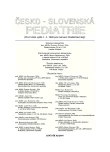The Muscle-bone Relationship in Cystic Fibrosis Patients
Authors:
E. Očenášková 1; K. Liebhardt 2; M. Stern 2; R. Schweizer 3; M. B. Ranke 3; D. D. Martin 3
Authors‘ workplace:
Pediatric Clinic, University Hospital Hradec Králové, Czech Republic
Head Assoc. Prof. MUDr. E. Pařízková, CSc.
1; Pediatrics I, University Children’s Hospital Tübingen, Germany
Head Prof. Dr. R. Handgretinger
2; Pediatric Endocrinology, University Children’s Hospital Tübingen, Germany
Head Prof. Dr. M. B. Ranke
3
Published in:
Čes-slov Pediat 2007; 62 (4): 204-212.
Category:
Original Papers
Overview
Objectives:
The multisystem involvement in cystic fibrosis (CF) patients may alter body composition and influence bone metabolism, leading to low bone mineral density and lean body mass depletion. Peripheral quantitative computed tomography (pQCT) allows assessment of volumetric bone mineral density and assessment of the relationship between bones and muscles.
Methods:
This study was conducted in 80 CF patients (aged 4.5–44.9 years, 36 female, 73% <18 years). Using pQCT, trabecular bone mineral density (TBD) in distal radius, cortical bone mineral density in proximal radius (CBD) and cross-section areas (CSA) of bone components and muscles in proximal forearm of the nondominant side were measured.
Results:
Weight, height and BMI of the patients were lower than in the normal population (mean SDS -1.13, -0.99 and -0.89, respectively, p<0.0001). TBD was not lower than normal (mean SDS 0.43, p = 0.064), CBD was higher than normal (mean value of SDS 0.38, p = 0.005). Cortical bone CSA and cortical thickness were small for age (mean value of SDS -0.95 and -0.93, p = <0.0001), but cortical bone CSA was appropriate for proximal forearm muscle CSA. Proximal forearm muscle CSA was smaller than both height-matched and age-matched references (mean value of SDS -1.84 and -1.41, p <0.0001 and <0.001, respectively).
Conclusions:
The thinner cortical bone found in CF patients may be due to their lower muscle mass. Changes in bone mineral density in CF have to be evaluated with caution.
Key words:
cystic fibrosis, bone mineral density, osteoporosis, pQCT
Labels
Neonatology Paediatrics General practitioner for children and adolescentsArticle was published in
Czech-Slovak Pediatrics

2007 Issue 4
Most read in this issue
- Prenatal Corticosteroids and Their Effects on the Fetus and Newborn Infant: Known and Secret
- Duchenne Muscular Dystrophy in a Girl
- Newborn Screening for Cystic Fibrosis in the Czech Republic: Results of a Pilot Study
- Langerhans’ Cell Histiocytosis in Children – Clinical Presentation, Diagnosis and Contemporary Therapeutic Options
